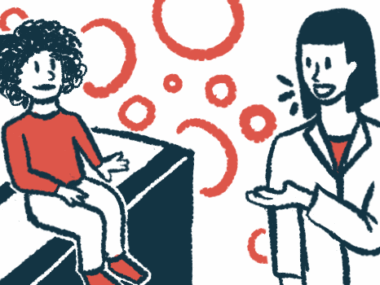Case report supports Upstaza for children older than 10 years
Upstaza was found to be effective in 2 children with severe AADC deficiency
Written by |

Note: This story has been updated May 25, 2023, to state that data from the two children in the report were part of the data package that supported Upstaza’s approval in the European Union and the U.K.
The first two aromatic l-amino acid decarboxylase (AADC) deficiency patients older than 10 years to be treated with Upstaza (eladocagene exuparvovec) in Europe experienced motor and nonmotor improvements over at least 1.5 years, a study shows.
The children, who had a severe form of the disease, received the one-time gene therapy under a European compassionate use program that allows certain patients to have access to yet-to-be-approved treatments.
Last year, Upstaza became the first approved disease-modifying therapy for AADC deficiency patients, 18 months and older, in the European Union (EU) and in the U.K. The company developing the treatment, PTC Therapeutics, is planning to apply for U.S. approval in the coming months.
These findings support the use of Upstaza in patients who are older than 10 years with severe forms of AADC deficiency, researchers noted.
The two cases were detailed in a brief report, “Intraputaminal Gene Delivery in Two Patients with Aromatic L-Amino Acid Decarboxylase Deficiency,” published in the journal Movement Disorders Clinical Practice.
In AADC deficiency, mutations in the DDC gene lead to reduced levels of AADC, an enzyme needed to produce dopamine and serotonin, two key neurotransmitters, or chemical messengers that nerve cells use to communicate.
The resulting neurotransmitter deficiency impairs nerve cell function and leads to symptoms such as developmental delays, movement and cognitive problems, oculogyric crises, sleeping difficulties, behavior problems, and seizures. Oculogyric crises are eye movement disorders marked by the gaze being involuntarily fixed upward.
About 80% of patients are considered severely affected, failing to meet major developmental milestones and remaining fully dependent on caregivers for their entire lives.
Upstaza designed to deliver healthy copy of DDC gene to cells
Formerly called PTC-AADC, Upstaza uses a modified and harmless virus to deliver a healthy copy of the DDC gene to cells, allowing them to produce a working AADC enzyme to restore neurotransmitter levels. The treatment is administered as a one-time infusion directly into the putamen, a brain region particularly affected by the disease.
Regulatory approvals in the EU and U.K. were supported by data from a Phase 1/2 trial (NCT01395641), a Phase 2b trial (NCT02926066) in Taiwan, and experiences with compassionate use programs involving eight children in Taiwan and two children in Europe.
Data from up to 30 children given Upstaza in Taiwan, who were under the age of 10 years at the time of treatment, showed motor and cognitive function improvements that were sustained for up to 10 years. Some children reached important motor milestones like walking without help or running freely.
Now, a team of researchers in France has described 1.5-year follow-up data from the two children treated in Europe under a compassionate use program. These were the first two AADC deficiency patients older than 10 to receive the gene therapy.
Both children, a girl and a boy, had a severe form of the disease, with symptom onset in the first months of life and diagnosis at the age of 2.8 years for the girl and 6 months for the boy.
They had no head control and limited voluntary movement despite standard treatment strategies. The girl received Upstaza at 10.7 years of age, and the boy at 11.4 years.
[Upstaza] can be considered for use in teenagers or older patients suffering from a severe form of AADCD with significant impairments.
Motor function improved with Upstaza
Results showed that motor function, especially muscles of the trunk and voluntary movements of limbs, improved with treatment. The boy could control head movements after six months, and the girl after 10 months.
Spontaneous and voluntary movements markedly improved from two months after receiving the gene therapy. Reaching for an object was achieved at six months post-treatment for the boy and after one year for the girl.
The duration, frequency, and severity of oculogyric crisis and dystonia, or involuntary muscle contractions, were progressively reduced three months after Upstaza treatment.
Regarding nonmotor features, both children had mood disorders and sleep disturbances before treatment, with excessive crying and communication only via eye contact and grunting.
Four weeks after the children received Upstaza, their caregivers/families reported improved sleep and reduced irritability for both children. Joyful behavior was also reported, including the girl’s new ability to laugh.
Both children also showed improvements in cognitive function and communication. Six months after treatment, they began to emit various sounds and syllables to call caregivers, and after 1.5 years, the girl could speak two-syllable words.
Enhanced feeding, including the boy’s weaning from a feeding tube, increased their body weight, and the boy also experienced fewer respiratory infections.
No serious adverse events reported
No serious adverse events occurred during the surgical procedure or follow-up. The boy, who had controlled epilepsy, experienced some seizures during a fever 36 hours after treatment. Both children experienced moderate and temporary involuntary, erratic movements four weeks after treatment, which were controlled with medication changes.
Post-surgery MRI scans confirmed no signs of bleeding or infection. Uptake of L-DOPA, a dopamine precursor, which was severely impaired in both children before treatment, improved one month after treatment and was sustained at least up to one year.
At last follow-up, the boy showed increased levels of a dopamine metabolite in the fluid that surrounds the brain and spinal cord, but unchanged levels of a serotonin metabolite. The girl’s dopamine levels remained stable.
“The clinical outcome in our two patients is concordant with previous reports,” the researchers wrote, “and confirms that [putamen] DDC gene delivery has a consistent safe profile.”
The gene therapy “can be considered for use in teenagers or older patients suffering from a severe form of AADCD with significant impairments,” they concluded.







